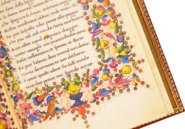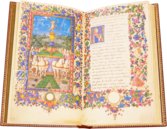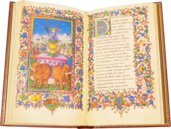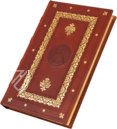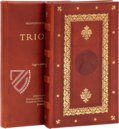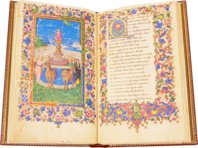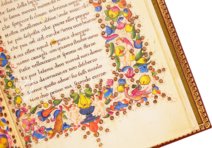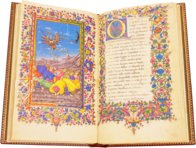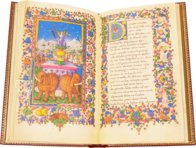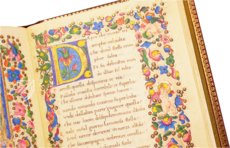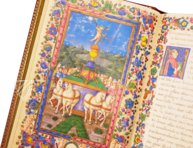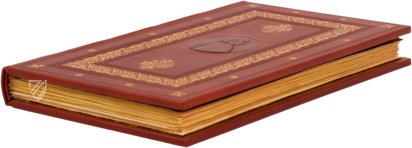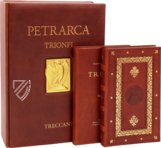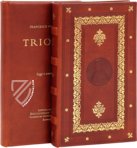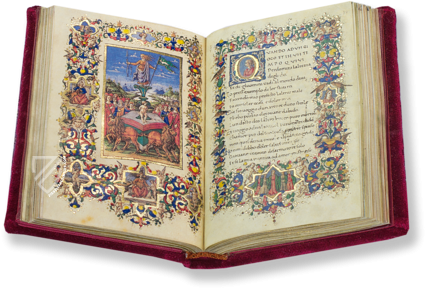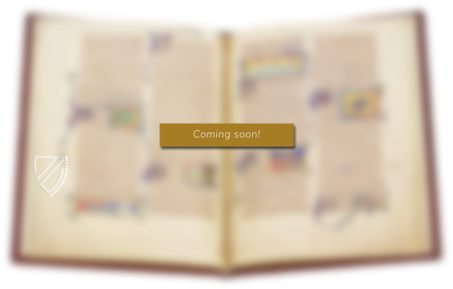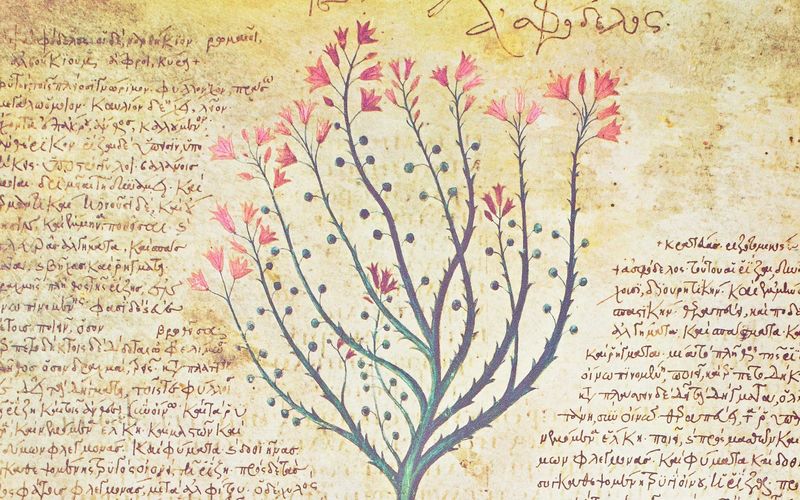Petrarca: Trionfi - Rome Codex
(1,000€ - 3,000€)
Francesco Petrarch's (1304–1374) Trionfi are among the most popular literary works of the Renaissance. In it, the great poet of the early Italian Renaissance sings of the triumph of Love, Chastity and Glory, the triumph of Time, the triumph of Death over Time and the triumph of Eternity, and thus sets forth his humanistic worldview entirely in the spirit of his time. In this precious manuscript from the second half of the 15th century, the famous miniaturist Francesco d'Antonio del Chierico, with the help of Zanobi Strozzi, embellished this great work of Italian literature and culture with beautiful pictorial decoration. Six wonderful full-page miniatures depict allegories of the Triumphs and are complemented by opulent borders and elaborate decorated initials. Finally, the lavish but subtle use of gold throughout the codex makes this copy of the Trionfi a secular luxury manuscript.
Petrarca: Trionfi
Known as the Roman Trionfi Codex, this manuscript is stored in the Biblioteca dell'Accademia Nazionale dei Lincei e Corsiniana in Rome. Originating from Florence during the second half of the 15th century, it both mirrors the spirit of humanism in the Italian Renaissance and offers an inside glimpse into the exuberant art of Italian illumination at that time.Francesco d’Antonio del Chierico (1433–1484), one of the greatest Florentine miniaturists of the 15th century, is responsible for this book decoration.
A Miniaturist of Princes and Monarchs
Del Chierico was employed by the Medici and Federico de Montefeltro inter alia, he also worked for famous patrons outside of Italy. He produced the decoration, consisting of six miniatures, wonderful frames, and decorative initials, probably with the help of Zanobi Strozzi. Bright flowers and exuberant ornamentation in true Renaissance style adorn the 120 pages of the manuscript, which are additionally furnished with precious gold, and thus presenting itself as a true luxury manuscript.
The Triumph Good and Beauty
The six full-page primary miniatures concerning the triumphs of time, love, chastity, glory, eternity, and over death illustrate the Italian text of the Trionfi by Francesco Petrarca (1304–1374). This work by the great poet and humanist of the early Renaissance stands firmly in the tradition of the time and was also popular and widely disseminated in the following centuries. The allegorical poem with six chapters concerning the triumph of good and beauty originated from the years 1350–74. Alongside generally moralizing sections, strongly autobiographical references are found in this text.
Doubly Significant
The manuscript at hand thus simultaneously combines two highpoints on its pages: a famous literary work by one of the most significant representatives of 14th century Italian literature and a testimonial to the grandiose art of a significant 15th century Florentine miniaturist!
Codicology
- Alternative Titles
- Triunfos de Petrarca
Il Trionfi di Francesco Petrarca
Petrarch's Triumphs
Les Triomphes de Petrarque
Petrarca: Triumphe
Petrarca: Trionfi - Römischer Codex - Size / Format
- 120 pages / 22.8 × 13.7 cm
- Origin
- Italy
- Date
- Second half of the 15th century
- Epochs
- Style
- Genre
- Language
- Script
- Humanistic minuscule
- Illustrations
- 6 full-page miniatures, borders, gold initials and one inhabited initial
- Content
- a series of allegorical poems
- Artist / School
- Francesco Petrarca (1304–1374) (author)
Francesco d’Antonio del Chierico (illuminator)
Petrarca: Trionfi - Rome Codex
Triumph of Death
In most illuminated copies of the Trionfi, all allegories are depicted on triumphal chariots – even though Petrarch only describes one in the case of the Triumph of Love. In this wonderful manuscript, however, the allegory of Death appears as a flying skeleton with bat-like wings whose tips appear razor-sharp – as does the oversized scythe with which Death is armed. The gruesome figure stands out particularly well against the rich blue of the sky in the background.
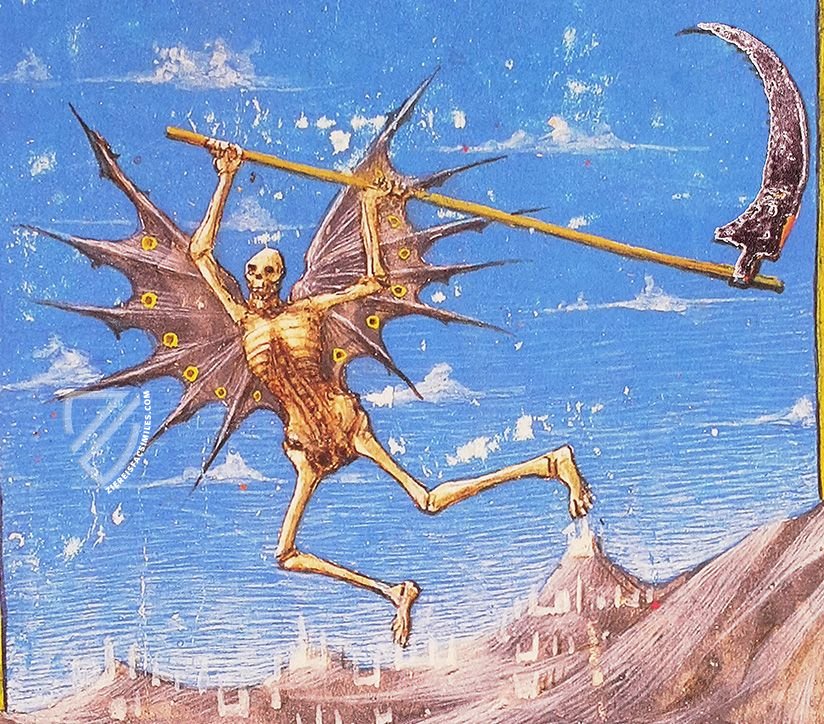
Petrarca: Trionfi - Rome Codex
Triumph of Love
This colorful miniature illustrating the first of the six Trionfi shows the allegory of love as a naked, blindfolded Cupid with bow and arrow, as described by Petrarch. He balances on a ball of fire protruding from a golden goblet, which in turn stands on a magnificent triumphal chariot pulled by four white, stately steeds.
The allegory of love is accompanied by all his conquests, who form an entire procession. Among them are illustrious historical, literary and mythological figures as well as ancient and medieval poets and troubadours. According to the text, the grassy path, which must be thought beyond the boundaries of the picture, finally leads the procession to the island of Cyprus, where Venus is said to have been born.
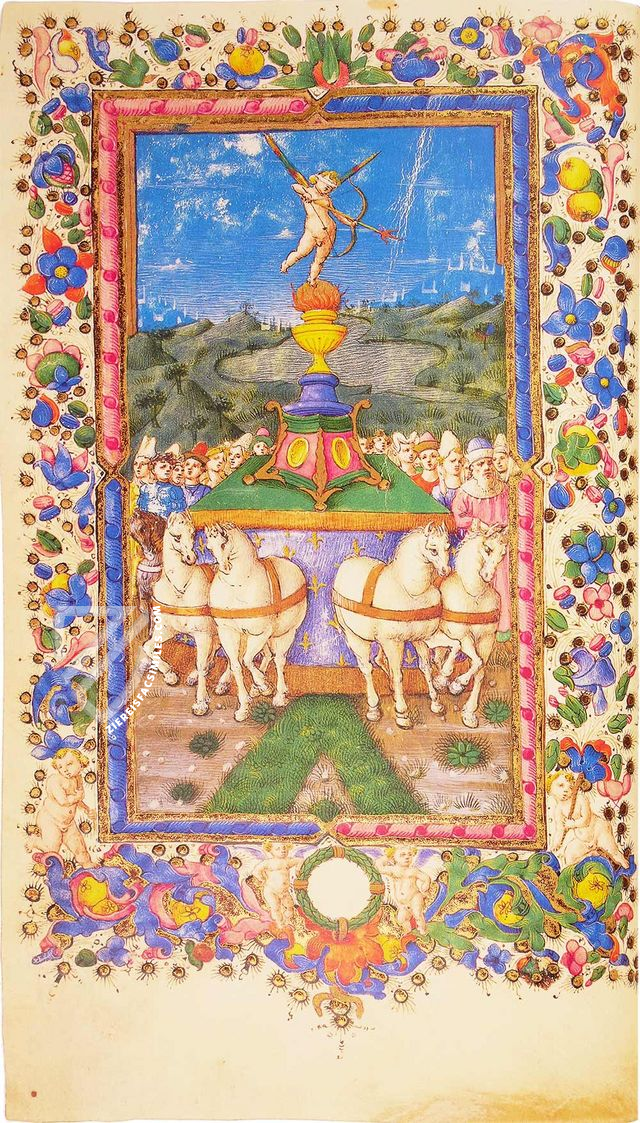
#1 Petrarca: Trionfi
Language: Italian
(1,000€ - 3,000€)
- Treatises / Secular Books
- Apocalypses / Beatus
- Astronomy / Astrology
- Bestiaries
- Bibles / Gospels
- Chronicles / History / Law
- Geography / Maps
- Saints' Lives
- Islam / Oriental
- Judaism / Hebrew
- Single Leaf Collections
- Leonardo da Vinci
- Literature / Poetry
- Liturgical Manuscripts
- Medicine / Botany / Alchemy
- Music
- Mythology / Prophecies
- Psalters
- Other Religious Books
- Games / Hunting
- Private Devotion Books
- Other Genres
- Afghanistan
- Armenia
- Austria
- Belgium
- Belize
- Bosnia and Herzegovina
- China
- Colombia
- Costa Rica
- Croatia
- Cyprus
- Czech Republic
- Denmark
- Egypt
- El Salvador
- Ethiopia
- France
- Germany
- Greece
- Guatemala
- Honduras
- Hungary
- India
- Iran
- Iraq
- Israel
- Italy
- Japan
- Jordan
- Kazakhstan
- Kyrgyzstan
- Lebanon
- Liechtenstein
- Luxembourg
- Mexico
- Morocco
- Netherlands
- Palestine
- Panama
- Peru
- Poland
- Portugal
- Romania
- Russia
- Serbia
- Spain
- Sri Lanka
- Sweden
- Switzerland
- Syria
- Tajikistan
- Turkey
- Turkmenistan
- Ukraine
- United Kingdom
- United States
- Uzbekistan
- Vatican City
- A. Oosthoek, van Holkema & Warendorf
- Aboca Museum
- Ajuntament de Valencia
- Akademie Verlag
- Akademische Druck- u. Verlagsanstalt (ADEVA)
- Aldo Ausilio Editore - Bottega d’Erasmo
- Alecto Historical Editions
- Alkuin Verlag
- Almqvist & Wiksell
- Amilcare Pizzi
- Andreas & Andreas Verlagsbuchhandlung
- Archa 90
- Archiv Verlag
- Archivi Edizioni
- Arnold Verlag
- ARS
- Ars Magna
- ArtCodex
- AyN Ediciones
- Azimuth Editions
- Badenia Verlag
- Bärenreiter-Verlag
- Belser Verlag
- Belser Verlag / WK Wertkontor
- Benziger Verlag
- Bernardinum Wydawnictwo
- BiblioGemma
- Biblioteca Apostolica Vaticana (Vaticanstadt, Vaticanstadt)
- Bibliotheca Palatina Faksimile Verlag
- Bibliotheca Rara
- Boydell & Brewer
- Bramante Edizioni
- Bredius Genootschap
- Brepols Publishers
- British Library
- C. Weckesser
- Caixa Catalunya
- Canesi
- CAPSA, Ars Scriptoria
- Caratzas Brothers, Publishers
- Carus Verlag
- Casamassima Libri
- Centrum Cartographie Verlag GmbH
- Chavane Verlag
- Christian Brandstätter Verlag
- Circulo Cientifico
- Club Bibliófilo Versol
- Club du Livre
- CM Editores
- Collegium Graphicum
- Collezione Apocrifa Da Vinci
- Comissão Nacional para as Comemorações dos Descobrimentos Portugueses
- Coron Verlag
- Corvina
- CTHS
- D. S. Brewer
- Damon
- De Agostini/UTET
- De Nederlandsche Boekhandel
- De Schutter
- Deuschle & Stemmle
- Deutscher Verlag für Kunstwissenschaft
- DIAMM
- Droz
- E. Schreiber Graphische Kunstanstalten
- Ediciones Boreal
- Ediciones Grial
- Ediclube
- Edições Inapa
- Edilan
- Editalia
- Edition Deuschle
- Edition Georg Popp
- Edition Leipzig
- Edition Libri Illustri
- Editiones Reales Sitios S. L.
- Éditions de l'Oiseau Lyre
- Editions Medicina Rara
- Editorial Casariego
- Editorial Mintzoa
- Editrice Antenore
- Editrice Velar
- Edizioni Edison
- Egeria, S.L.
- Eikon Editores
- Electa
- Emery Walker Limited
- Enciclopèdia Catalana
- Eos-Verlag
- Ephesus Publishing
- Ernst Battenberg
- Eugrammia Press
- Extraordinary Editions
- Fackelverlag
- Facsimila Art & Edition
- Facsimile Editions Ltd.
- Facsimilia Art & Edition Ebert KG
- Faksimile Verlag
- Feuermann Verlag
- Folger Shakespeare Library
- Franco Cosimo Panini Editore
- Friedrich Wittig Verlag
- Fundación Hullera Vasco-Leonesa
- G. Braziller
- Gabriele Mazzotta Editore
- Gebr. Mann Verlag
- Gesellschaft für graphische Industrie
- Getty Research Institute
- Giovanni Domenico de Rossi
- Giunti Editore
- Graffiti
- Grafica European Center of Fine Arts
- Guido Pressler
- Guillermo Blazquez
- Gustav Kiepenheuer
- H. N. Abrams
- Harrassowitz
- Harvard University Press
- Helikon
- Hendrickson Publishers
- Henning Oppermann
- Herder Verlag
- Hes & De Graaf Publishers
- Hoepli
- Holbein-Verlag
- Houghton Library
- Hugo Schmidt Verlag
- Idion Verlag
- Il Bulino, edizioni d'arte
- ILte
- Imago
- Insel Verlag
- Instituto de Estudios Altoaragoneses
- Instituto Nacional de Antropología e Historia
- Istituto dell'Enciclopedia Italiana - Treccani
- Istituto Ellenico di Studi Bizantini e Postbizantini
- Istituto Geografico De Agostini
- Istituto Poligrafico e Zecca dello Stato
- Italarte Art Establishments
- Jan Thorbecke Verlag
- Johnson Reprint Corporation
- Josef Stocker
- Josef Stocker-Schmid
- Jugoslavija
- Karl W. Hiersemann
- Kasper Straube
- Kaydeda Ediciones
- Kindler Verlag / Coron Verlag
- Kodansha International Ltd.
- Konrad Kölbl Verlag
- Kurt Wolff Verlag
- La Liberia dello Stato
- La Linea Editrice
- La Meta Editore
- Lambert Schneider
- Landeskreditbank Baden-Württemberg
- Leo S. Olschki
- Les Incunables
- Liber Artis
- Library of Congress
- Libreria Musicale Italiana
- Lichtdruck
- Lito Immagine Editore
- Lumen Artis
- Lund Humphries
- M. Moleiro Editor
- Maison des Sciences de l'homme et de la société de Poitiers
- Manuscriptum
- Martinus Nijhoff
- Maruzen-Yushodo Co. Ltd.
- MASA
- Massada Publishers
- McGraw-Hill
- Metropolitan Museum of Art
- Militos
- Millennium Liber
- Müller & Schindler
- Nahar - Stavit
- Nahar and Steimatzky
- National Library of Wales
- Neri Pozza
- Nova Charta
- Oceanum Verlag
- Odeon
- Orbis Mediaevalis
- Orbis Pictus
- Österreichische Staatsdruckerei
- Oxford University Press
- Pageant Books
- Parzellers Buchverlag
- Patrimonio Ediciones
- Pattloch Verlag
- PIAF
- Pieper Verlag
- Plon-Nourrit et cie
- Prestel Verlag
- Princeton University Press
- Prisma Verlag
- Priuli & Verlucca, editori
- Pro Sport Verlag
- Propyläen Verlag
- Pytheas Books
- Quaternio Verlag Luzern
- Reales Sitios
- Recht-Verlag
- Reichert Verlag
- Reichsdruckerei
- Reprint Verlag
- Riehn & Reusch
- Roberto Vattori Editore
- Rosenkilde and Bagger
- Roxburghe Club
- Salerno Editrice
- Saltellus Press
- Sandoz
- Sarajevo Svjetlost
- Schöck ArtPrint Kft.
- Schulsinger Brothers
- Scolar Press
- Scrinium
- Scripta Maneant
- Scriptorium
- Shazar
- Siloé, arte y bibliofilia
- SISMEL - Edizioni del Galluzzo
- Sociedad Mexicana de Antropología
- Société des Bibliophiles & Iconophiles de Belgique
- Soncin Publishing
- Sorli Ediciones
- Stainer and Bell
- Studer
- Styria Verlag
- Sumptibus Pragopress
- Szegedi Tudomànyegyetem
- Taberna Libraria
- Tarshish Books
- Taschen
- Tempus Libri
- Testimonio Compañía Editorial
- Thames and Hudson
- The Clear Vue Publishing Partnership Limited
- The Facsimile Codex
- The Folio Society
- The Marquess of Normanby
- The Richard III and Yorkist History Trust
- Tip.Le.Co
- TouchArt
- TREC Publishing House
- TRI Publishing Co.
- Trident Editore
- Typis Regiae Officinae Polygraphicae
- Union Verlag Berlin
- Universidad de Granada
- University of California Press
- University of Chicago Press
- Urs Graf
- Vallecchi
- Van Wijnen
- VCH, Acta Humaniora
- VDI Verlag
- VEB Deutscher Verlag für Musik
- Verlag Anton Pustet / Andreas Verlag
- Verlag Bibliophile Drucke Josef Stocker
- Verlag der Münchner Drucke
- Verlag für Regionalgeschichte
- Verlag Styria
- Vicent Garcia Editores
- W. Turnowski Ltd.
- W. Turnowsky
- Waanders Printers
- Wiener Mechitharisten-Congregation (Wien, Österreich)
- Wissenschaftliche Buchgesellschaft
- Wissenschaftliche Verlagsgesellschaft
- Wydawnictwo Dolnoslaskie
- Xuntanza Editorial
- Zakład Narodowy
- Zollikofer AG






